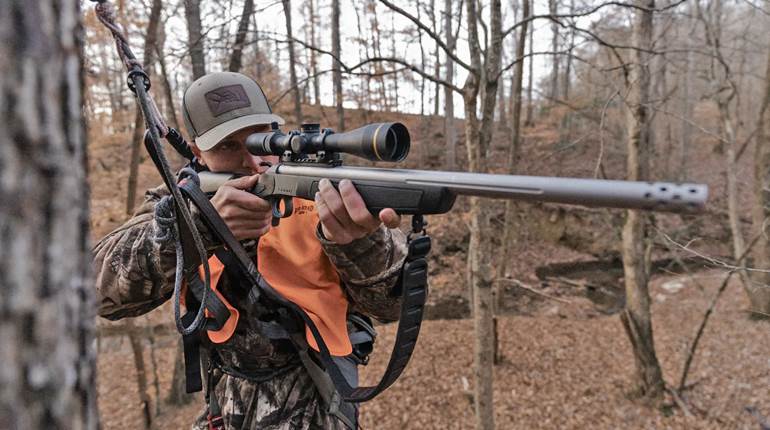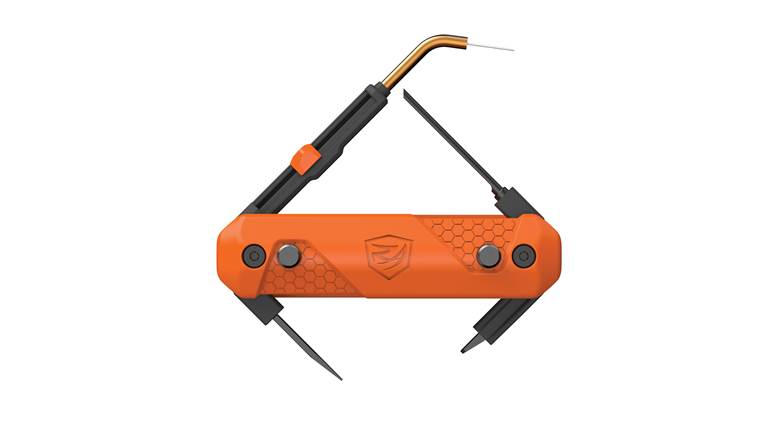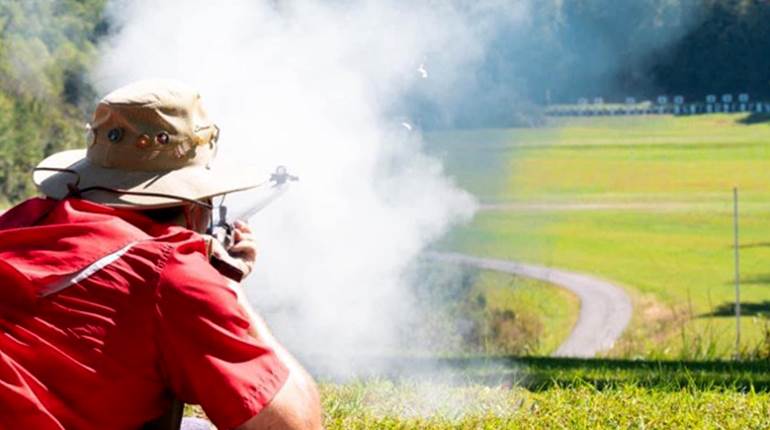
Recognized for its high-quality, yet economical, muzzleloaders and switch-barrel long guns, CVA has also manufactured dedicated Spanish-made single-shot rifles since 2010, with the debut of the Scout. As of 2012, the Scout was in its second iteration, the V2, which incorporated many of the “premium” features found on the company’s muzzleloaders. This rightly increased the price. In upgrading the Scout, CVA left a niche for a no-frills, value-priced, entry-level rifle. To fill this void, the company introduced the Hunter.
Unsurprisingly, the break-action, single-shot, center-fire Hunter employs tried-and-true technologies from the company’s extensive line of muzzleloaders. The receiver’s profile, for example, mimics that of the Optima V2 muzzleloader; however, it is machined from a 4140 chromoly steel investment casting, and not aluminum, to withstand the high pressures generated by center-fire cartridges. Moreover, the black, synthetic fore-end, which has a distinct drop, or “belly” mid-length, molded-in checkering, and a steel sling swivel stud likewise comes by way of the Optima V2. Also “borrowed” from the aforementioned model is the ambidextrous, synthetic buttstock, which features a panel of molded-in checkering on the pistol grip, an integral sling swivel stud, and a 3/4"-thick CrushZone recoil pad. The steel breeching lever, which projects through, and well forward of, the front of the polymer, one-piece trigger guard, mimics that used on the low-cost CVA Wolf muzzleloader. Less aesthetically pleasing than that used on the Scout or the “premium” muzzleloaders, it is nonetheless a rapid, reliable method to access the chamber for loading and unloading. Deeply cut horizontal grooves on the lever’s face ensure ample purchase.
Like most break-action, single-shot rifles, the Hunter has an external steel hammer that is threaded to accept a removable spur. There is no external safety; instead, the rifle has an automatic hammer block that prevents the hammer from contacting the firing pin unless the trigger is pressed. Although CVA’s website doesn’t denote the Hunter as having the company’s top-notch Neutral Center of Gravity Trigger (NCGT), we verified with company personnel that it does, indeed, have the NCGT. We were pleasantly surprised with the test rifle’s trigger characteristics; there was no discernible creep or overtravel, and it broke with a 2-lb., 15-oz. pull. It was among the best triggers we’ve encountered recently, regardless of price point.
The CVA Hunter is available in two configurations: the 14" length-of-pull “standard” model and a 13" length-of-pull “compact” variant. Whereas the former has a 22" blued, non-fluted steel barrel, the compact’s is 2" shorter. There’s also a 16"-barreled version in .300 Blackout that is threaded to accept a sound suppressor. On the .44 Rem. Mag. evaluation rifle, the barrel measured 0.995" in diameter at the breech and 0.804" at the muzzle. Furthermore, the barrels are fitted with extractors (not ejectors), end with a recessed, target-style muzzle crown, and are devoid of iron sights. Instead, they are drilled and tapped for scope bases, and included with the rifle is a one-piece DEAD-ON base with integral rings. As for the rifling’s rate of twist, much forethought went into the selection process—especially for the .44 Rem. Mag. version. For example, although the SAAMI standard is 1:38" and some companies use 1:32", CVA opted for 1:20", the same as found in the S&W Model 29, which is recognized for excellent accuracy with mid- to heavyweight .44-cal. bullets.
In addition to .300 Blackout, the full-size Hunter is available in .35 Rem., .35 Whelen, and .44 Rem. Mag., while the compact version comes in .243 Win., 7 mm-08 Rem., and .35 Rem. If some of these chamberings seem unusual, that’s because they were selected to fall within specific parameters outlined by several states’ game laws. Take the .44 Rem. Mag. for example; the cartridge’s bullet diameter and case length enable its use in a rifle during the Indiana firearm deer season, which is otherwise restricted to shotguns, certain handguns, and muzzleloading long guns or handguns. For the 2014/2015 season, the .44 Rem. Mag.-chambered Hunter would be legal for use during Ohio’s firearm season, too. Similarly, a CVA Hunter in either of the two .35-cal. chamberings meets the criteria for hunting Louisiana’s Primitive Firearms Season for whitetail deer.
We requested a Hunter chambered in .44 Rem. Mag., to which we mounted a Leupold VX-1 2-7X 33 mm scope in the provided DEAD-ON base with integral rings. Accuracy testing was conducted at 100 yds. using three loads: Herter’s Select Grade Brass Case 240-gr. soft-point; Hornady LEVERevolution 225-gr. FTX; and Hornady Custom 240-gr. XTP. Hornady’s LEVERevolution proved to be the most compatible with the test rifle, producing a 2.75" average for five consecutive, five-shot groups. In most cases, three, if not four, of the FTX bullets impacted closely; however, in each group there was at least one flier that greatly increased the group size. The likely culprit was inconsistent cheekweld (broken after each shot) and fore-end pressure. Still, for hunting deer-size game even out to 150 yds., it’s entirely sufficient. Hornady’s Custom load scored second best, producing a 2.94"-average for 25 shots. Whereas the Hornady loads had standard deviations (Sd) of 8 and 7, respectively, the Herter’s load posted an Sd of 22; differences in recoil and report within even five-shot strings with the Herter’s load confirmed its inconsistency, and no doubt played a role in the average group size measuring 3.80".
Eye-opening was the increase in velocity over factory-touted numbers; absent the barrel-cylinder gap and abbreviated barrel of a revolver, the Hornady LEVERevolution gained 435 f.p.s., and the Custom offering realized a 520-f.p.s. increase in speed. This “flattens” trajectory and increases the energy delivered on-target.
With accuracy testing completed, we transitioned to rapid shouldering and firing drills. Doing so revealed that the slightly tacky material and shape of the CrushZone recoil pad caused it to snag at times, and its stiffness did little to mitigate recoil. We appreciated the trigger’s long, thin shoe but noted that the trigger guard’s small size could impede access by a gloved finger. There were no mechanical issues whatsoever. Lastly, in observing the fit and finish of the Hunter, we did see some remnant machining marks on the top, rear side of the receiver, and the “wings” of the synthetic fore-end weren’t a perfect fit to the machined contours of the receiver.
Despite the aforementioned nitpicking, we found the CVA Hunter to be a solid, value-priced firearm that is capable of fulfilling the task for which it was created. In the end, that is what really matters.
Importer: Blackpowder Products, Inc., 1685 Boggs Road, Suite 300, Duluth, GA 30096; (770) 449-4687; cva.com
Caliber: .243 Win., 7 mm-08 Rem., .300 Blackout, .35 Rem., .35 Whelen, .44 Rem. Mag. (tested)
Action Type: break-action, single-shot center-fire rifle
Receiver: blued 4140 chromoly steel
Barrel: non-fluted, blued steel
Rifling: six-groove, 1:20" RH twist (.44 Rem. Mag.); 1:9" (7 mm-08 Rem.); 1:10" (.243 Win., .300 Blackout); 1:14" (.35 Rem., .35 Whelen)
Sights: none; drilled and tapped for scope bases (DEAD-ON base/rings included)
Trigger: single-stage, non-adjustable; 2-lb., 15-oz. pull
Stock: synthetic; length of pull, 13" (compact) or 14" (standard); drop at comb, 11⁄8"; drop at heel, 15⁄8"
Overall Length: 38" (standard), 35" (compact)
Weight: 5 lbs., 13 ozs. (standard), 5 lbs., 8 ozs. (compact)
Accessories: owner’s manual
Suggested Retail Price: $315







































